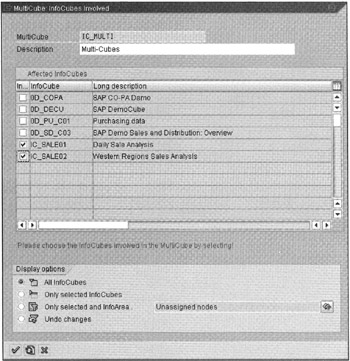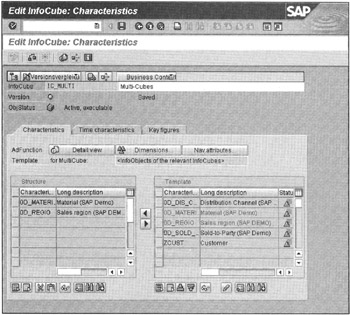Joining InfoCubes
This is a new feature in SAP BW 2.0. The MultiCube is simply a definition, or view, that is based on multiple InfoCubes. Actual data remains in the source InfoCubes. Data is fetched at run time from source InfoCubes in parallel to improve performance.
From the BEX Analyzer, the MultiCube looks as if it is a true InfoCube. Note that because it represents a view against existing InfoCubes, there are no update rules for the MultiCube InfoCubes.
InfoCubes are usually subject-centric. However, business decision-makers often want to pull information together across all organizations. Under such a scenario, you can define the MultiCube view against individual InfoCubes. For example, a supply-chain analyst might want to know details of order, delivery, and billing statistics in one view. In this case, you can define a MultiCube against Customer, Deliveries, and Billing InfoCubes and select characteristics and key figures needed for the analysis from individual InfoCubes.
Though the MultiCube feature is available in SAP BW 2.0, one has to be very careful when defining a MultiCube because the performance of the SAP BW server could be impacted. Remember that the MultiCube result set is a union of the InfoCubes. Because you access two or more InfoCubes, and depending on how many items are selected from each InfoCube, the query result set could be doubled or tripled, and that could consume a lot of SAP BW system, network, and client workstation resources.
Moreover, you have to be very aware of the update rules used to compute key figures in all InfoCubes used to define a MultiCube. Knowledge of update rules is critical to interpret query results accurately. For example, say you have one InfoCube for the sales organization with key figure revenue and another InfoCube for the marketing organization with the same key figure revenue. To obtain combined revenue, you can join these InfoCubes to define a MultiCube. A query against this MultiCube lists sales and marketing revenues side by side, but are revenues accurate? They may or may not be for the following reason. The sales organization revenue figures are calculated based on sales region and product sold, and the marketing revenues are defined by marketing campaign and product sold. Though both organizations use the same key figure, revenue, update rules in each InfoCube are different. When joining these two InfoCubes to list revenues, you will be comparing apples and oranges; it does not make sense to make strategic decisions by looking at these revenue figures.
Therefore, it is very important to understand update rules for all InfoCubes used to define a MultiCube. Once update rules are understood, the MultiCubes are a good candidate for building executive information systems or corporate-wide high-level cross-organization analytical applications for senior management.
Defining a MultiCube InfoCube in SAP BW 2.0A
Defining a MultiCube InfoCube is relatively simpler than building an InfoCube. When creating an InfoCube, select the InfoCube type as MultiCube. The system will display the available InfoCubes for the join. Select the InfoCubes you need for this new MultiCube definition, as shown in Figure 12-12. From here on, the process is the same as when you select characteristics, time, and key figures available in individual InfoCubes. Define the newly assigned dimensions, select key figures, save, and activate the MultiCube, as shown in Figure 12-13. No update rules are needed.

Figure 12-12: Selecting InfoCubes or MultiCube InfoCubes in SAP BW 2.0A.

Figure 12-13: MultiCube InfoCube Saved and Activated. Looks and Behaves Exactly Like a Typical InfoCube.
As the size of the InfoCube increases, it slows end-user query response time. To improve query response time, several aggregate cubes are defined against one single InfoCube. This is discussed further in Chapter 16, "Managing SAP BW-Performance and Sizing Tuning."
| Team-Fly |
EAN: 2147483647
Pages: 174